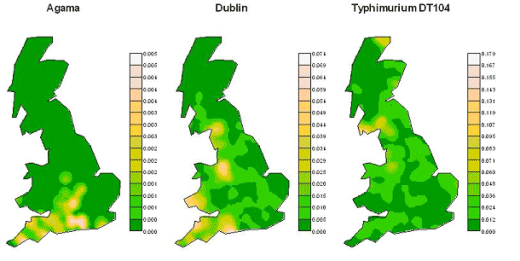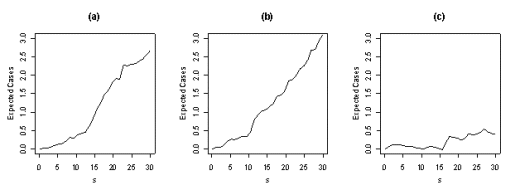|
The space-time analysis studied whether spatial and temporal clustering exist in Salmonella outbreaks.
Spatial clustering
Figure 1 highlights areas within the UK that have a higher number of cases of Salmonella compared to the underlying cattle population.

Figure 1: Maps of UK showing the risk for each strain of salmonella, ie. highernumbers of cases of Salmonella in comparison to the underlying cattle population.
The different spatial distributions for Agama, Dublin and Typhimurium reflect their varying characteristics.
Salmonella Agama:
Found only in Wales, SW England and the Midlands.
Endemic in cattle population,
Unusual distribution suggests possible role for wildlife reservoirs in transmission.
Salmonella Dublin:
Found throughout the UK, with high density around main dairy regions of Cheshire, Pembrokeshire and SW England,
Endemic in cattle population, displaying a stable spatial structure,
Distribution closely follows that of the UK cattle population.
Salmonella Typhimurium:
High density around Cheshie, SW England, Thurso and Dumfries and Galloway,
Epidemic strain first emerging in the 1990's,
Distinct areas where Typhimurium cases exist and Dublin does not (and vice-versa). The reason for this is that Typhimurium has not spread to those areas, rather than one strain not being as competitive.

Figure 2: Expected number of positive farms within a distance s km of an arbitrary positive farm for (a) Agama, (b) Dublin and (c) Typhimurium.
Temporal clustering
Salmonella Typhimurium first emerged early in the 1990's, rising sharply and peaking during 1995/96, and since then there has been a steady decline in numbers. Concentrating on the period during 1994-95 (approaching the peak of Typhimurium), the number of new incidents per month can be plotted, as shown in Figure 3.

Figure 3: Number of incidents of each strain of salmonella, per month, during the two year period of 1994-95.
For all three strains, in both 1994 and 1995, there is a peak in the number of new incidents of Salmonella during autumn and early winter. Further statistical analysis shows that there does not exist homogeneity in the rates of infection throughout the year.
|

